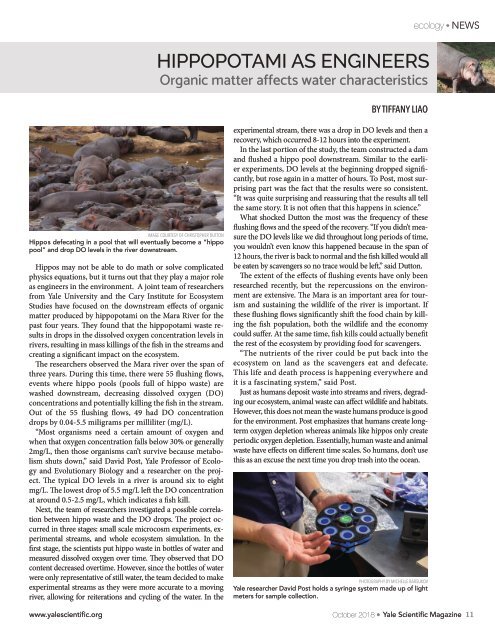YSM Issue 91.3
Create successful ePaper yourself
Turn your PDF publications into a flip-book with our unique Google optimized e-Paper software.
ecology<br />
NEWS<br />
HIPPOPOTAMI AS ENGINEERS<br />
Organic matter affects water characteristics<br />
BY TIFFANY LIAO<br />
IMAGE COURTESY OF CHRISTOPHER DUTTON<br />
Hippos defecating in a pool that will eventually become a “hippo<br />
pool” and drop DO levels in the river downstream.<br />
Hippos may not be able to do math or solve complicated<br />
physics equations, but it turns out that they play a major role<br />
as engineers in the environment. A joint team of researchers<br />
from Yale University and the Cary Institute for Ecosystem<br />
Studies have focused on the downstream effects of organic<br />
matter produced by hippopotami on the Mara River for the<br />
past four years. They found that the hippopotami waste results<br />
in drops in the dissolved oxygen concentration levels in<br />
rivers, resulting in mass killings of the fish in the streams and<br />
creating a significant impact on the ecosystem.<br />
The researchers observed the Mara river over the span of<br />
three years. During this time, there were 55 flushing flows,<br />
events where hippo pools (pools full of hippo waste) are<br />
washed downstream, decreasing dissolved oxygen (DO)<br />
concentrations and potentially killing the fish in the stream.<br />
Out of the 55 flushing flows, 49 had DO concentration<br />
drops by 0.04-5.5 miligrams per milliliter (mg/L).<br />
“Most organisms need a certain amount of oxygen and<br />
when that oxygen concentration falls below 30% or generally<br />
2mg/L, then those organisms can’t survive because metabolism<br />
shuts down,” said David Post, Yale Professor of Ecology<br />
and Evolutionary Biology and a researcher on the project.<br />
The typical DO levels in a river is around six to eight<br />
mg/L. The lowest drop of 5.5 mg/L left the DO concentration<br />
at around 0.5-2.5 mg/L, which indicates a fish kill.<br />
Next, the team of researchers investigated a possible correlation<br />
between hippo waste and the DO drops. The project occurred<br />
in three stages: small scale microcosm experiments, experimental<br />
streams, and whole ecosystem simulation. In the<br />
first stage, the scientists put hippo waste in bottles of water and<br />
measured dissolved oxygen over time. They observed that DO<br />
content decreased overtime. However, since the bottles of water<br />
were only representative of still water, the team decided to make<br />
experimental streams as they were more accurate to a moving<br />
river, allowing for reiterations and cycling of the water. In the<br />
experimental stream, there was a drop in DO levels and then a<br />
recovery, which occurred 8-12 hours into the experiment.<br />
In the last portion of the study, the team constructed a dam<br />
and flushed a hippo pool downstream. Similar to the earlier<br />
experiments, DO levels at the beginning dropped significantly,<br />
but rose again in a matter of hours. To Post, most surprising<br />
part was the fact that the results were so consistent.<br />
“It was quite surprising and reassuring that the results all tell<br />
the same story. It is not often that this happens in science.”<br />
What shocked Dutton the most was the frequency of these<br />
flushing flows and the speed of the recovery. “If you didn’t measure<br />
the DO levels like we did throughout long periods of time,<br />
you wouldn’t even know this happened because in the span of<br />
12 hours, the river is back to normal and the fish killed would all<br />
be eaten by scavengers so no trace would be left,” said Dutton.<br />
The extent of the effects of flushing events have only been<br />
researched recently, but the repercussions on the environment<br />
are extensive. The Mara is an important area for tourism<br />
and sustaining the wildlife of the river is important. If<br />
these flushing flows significantly shift the food chain by killing<br />
the fish population, both the wildlife and the economy<br />
could suffer. At the same time, fish kills could actually benefit<br />
the rest of the ecosystem by providing food for scavengers.<br />
“The nutrients of the river could be put back into the<br />
ecosystem on land as the scavengers eat and defecate.<br />
This life and death process is happening everywhere and<br />
it is a fascinating system,” said Post.<br />
Just as humans deposit waste into streams and rivers, degrading<br />
our ecosystem, animal waste can affect wildlife and habitats.<br />
However, this does not mean the waste humans produce is good<br />
for the environment. Post emphasizes that humans create longterm<br />
oxygen depletion whereas animals like hippos only create<br />
periodic oxygen depletion. Essentially, human waste and animal<br />
waste have effects on different time scales. So humans, don’t use<br />
this as an excuse the next time you drop trash into the ocean.<br />
PHOTOGRAPHY BY MICHELLE BARSUKOV<br />
Yale researcher David Post holds a syringe system made up of light<br />
meters for sample collection.<br />
www.yalescientific.org<br />
October 2018<br />
Yale Scientific Magazine<br />
11


















